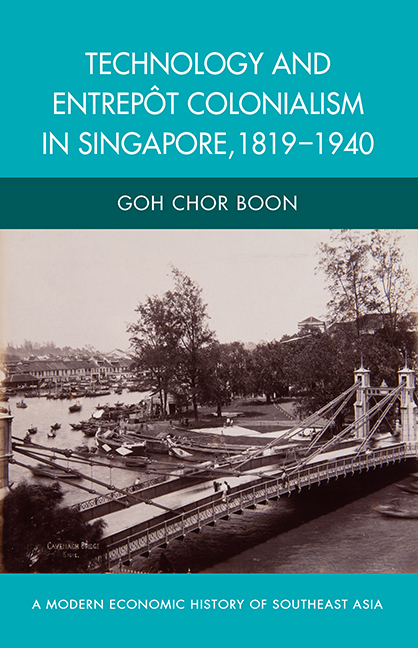Book contents
- Frontmatter
- Contents
- List of Figures and Tables
- Notes on Currency
- Introduction
- 1 Technology and the British Empire
- 2 Pioneers of Change: Entrepreneurs and Engineers
- 3 Maritime Technology and Development of the Port
- 4 Introducing Technological Systems
- 5 Sanitation and Public Health
- 6 Agriculture and Colonial Science
- 7 Food and Singapore Cold Storage
- 8 Politics of Imperial Education
- 9 Technology Transfer and Limited Industrial Growth
- Conclusion
- Bibliography
- Index
4 - Introducing Technological Systems
Published online by Cambridge University Press: 21 October 2015
- Frontmatter
- Contents
- List of Figures and Tables
- Notes on Currency
- Introduction
- 1 Technology and the British Empire
- 2 Pioneers of Change: Entrepreneurs and Engineers
- 3 Maritime Technology and Development of the Port
- 4 Introducing Technological Systems
- 5 Sanitation and Public Health
- 6 Agriculture and Colonial Science
- 7 Food and Singapore Cold Storage
- 8 Politics of Imperial Education
- 9 Technology Transfer and Limited Industrial Growth
- Conclusion
- Bibliography
- Index
Summary
Between 1870 and 1930, the trading port of Singapore changed in ways that Stamford Raffles could never have dreamed possible. The opening of the technological wonder in the form of the Suez Canal in 1869 heralded an exciting era for the trading town whose population of less than 100,000 depended largely on the buying and selling of local and imported goods. The healthy economy had attracted ever-increasing numbers of immigrants during the period 1870 to 1900. The population increased from 97,111 in 1871 to 228,555 in 1901, largely due to a massive arrival of about 110,000 Chinese during this period. The number of Europeans and Americans also showed an increase from 922 (of which 594 were British) in 1871 to 2,861 (of which 1,880 were British) in 1901. Together with other prominent colonial cities like Algiers, Cairo and Delhi, Singapore was developed to serve as an economic and political centre of British rule in this region.
With the arrival of the steamship into the expanding harbour, the people slowly but surely began to enjoy the fruits of Western industrialization which took place thousands of miles away. Ships brought along goods, machinery, equipment and household gadgets of all kinds — and foreigners of different races and with different skills and professions. In the United States and Britain, by the end of the nineteenth century, the process of industrialization led to the rapid transition of pre-industrial rural towns to industrial urbanized cities. In the quest for urban environmental improvements in the modern era, medical doctors prescribed new standards, engineers constructed more effective equipment and civil servants created new public institutions. While American engineers built with anticipation of advances still to come, British engineers and technologists often indulged in what Arnold Pacey termed as “idealistic engineering” — constructing huge monuments to idealize “Progress”, such as in Britain where “engineers working on municipal sewerage and water projects or employed by the Metropolitan Board of Works in London built monumental pumping stations and other structures of extravagantly high quality”. Britain's colonial “estate” like Singapore was gradually transformed, especially from the last quarter of the nineteenth century, by technological systems that stimulated individuals to become more dependent on one another.
- Type
- Chapter
- Information
- Technology and Entrepot Colonialism in Singapore, 1819–1940 , pp. 93 - 119Publisher: ISEAS–Yusof Ishak InstitutePrint publication year: 2013

